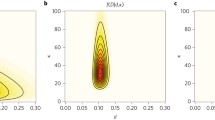Abstract
Tuffley and Steel (Bull. Math. Biol. 59:581–607, 1997) proved that maximum likelihood and maximum parsimony methods in phylogenetics are equivalent for sequences of characters under a simple symmetric model of substitution with no common mechanism. This result has been widely cited ever since. We show that small changes to the model assumptions suffice to make the two methods inequivalent. In particular, we analyze the case of bounded substitution probabilities as well as the molecular clock assumption. We show that in these cases, even under no common mechanism, maximum parsimony and maximum likelihood might make conflicting choices. We also show that if there is an upper bound on the substitution probabilities which is ‘sufficiently small’, every maximum likelihood tree is also a maximum parsimony tree (but not vice versa).
Similar content being viewed by others
References
Bandelt, H.-J., Fischer, M., 2008. Perfectly misleading distances from ternary characters. Syst. Biol. 57(4), 540–543.
Felsenstein, J., 1978. Cases in which parsimony or compatibility will be positively misleading. Syst. Zool. 27, 401–410.
Felsenstein, J., 2004. Inferring Phylogenies. Sinauer, Sunderland.
Hendy, M., Penny, D., 1989. A framework for the qualitative study of evolutionary trees. Syst. Zool. 38, 297–309.
Huson, D., Steel, M., 2004. Distances that perfectly mislead. Syst. Biol. 53(2), 327–332.
Jukes, T., Cantor, C., 1969. Evolution of protein molecules. In: Mammalian Protein Metabolism, pp. 21–132. Academic Press, San Diego.
Neyman, J., 1971. Molecular studies of evolution: A source of novel statistical problems. In: Statistical Decision Theory and Related Topics, pp. 1–27. Academic Press, San Diego.
Semple, C., Steel, M., 2003. Phylogenetics. Oxford University Press, London.
Tuffley, C., Steel, M., 1997. Links between maximum likelihood and maximum parsimony under a simple model of site substitution. Bull. Math. Biol. 59, 581–607.
Yang, Z., 2006. Computational Molecular Evolution. Oxford University Press, London.
Author information
Authors and Affiliations
Corresponding author
Rights and permissions
About this article
Cite this article
Fischer, M., Thatte, B. Revisiting an Equivalence Between Maximum Parsimony and Maximum Likelihood Methods in Phylogenetics. Bull. Math. Biol. 72, 208–220 (2010). https://doi.org/10.1007/s11538-009-9446-2
Received:
Accepted:
Published:
Issue Date:
DOI: https://doi.org/10.1007/s11538-009-9446-2




